Differential Rotation in Convecting Spherical Shells with Non-Uniform Viscosity and Entropy Diffusivity
Abstract
1. Introduction
2. Mathematical Model
3. Results
3.1. Design of the Study and Choice of Parameter Values
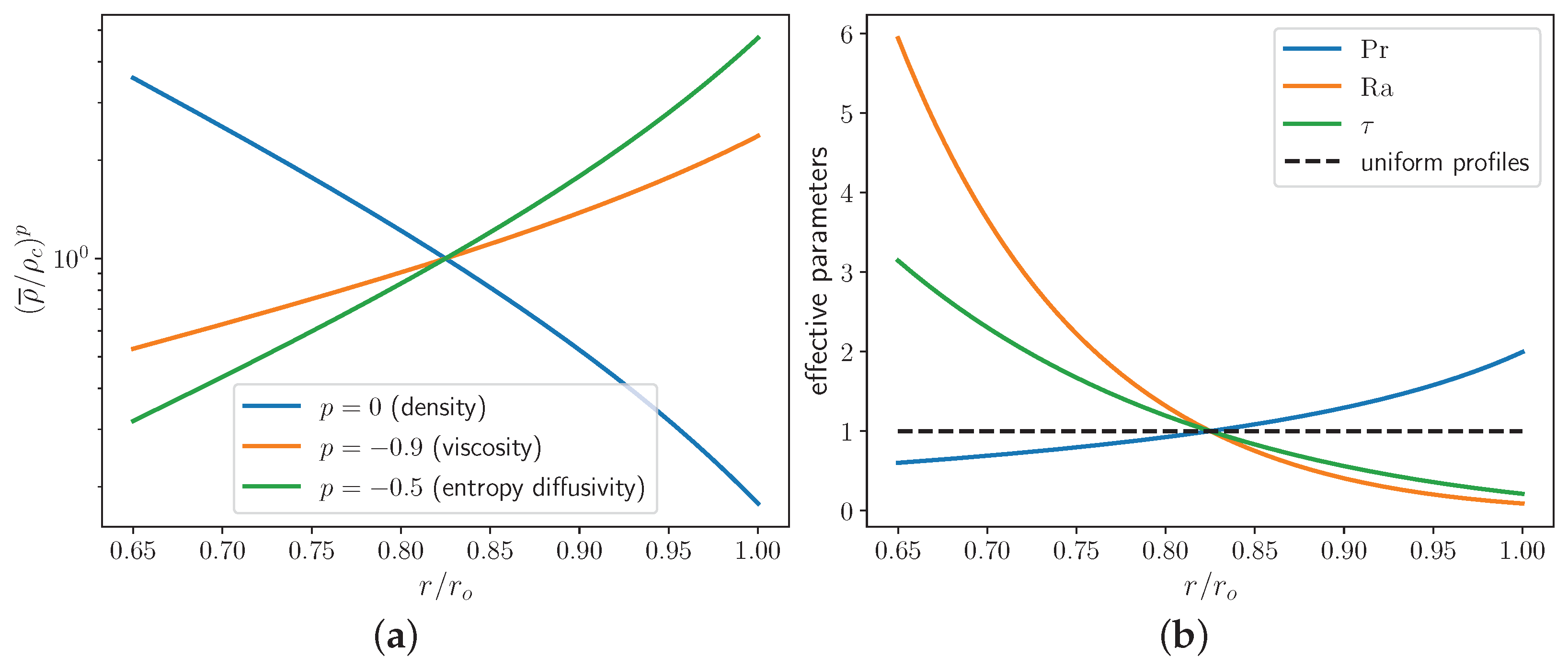
3.2. Direct Comparison between Simulated Differential Rotation and Observations
4. Discussion including Further Results
4.1. Structure of the Flow and Thermal Wind Balance
4.2. Secondary Considerations
5. Conclusions
Author Contributions
Funding
Data Availability Statement
Acknowledgments
Conflicts of Interest
References
- Miesch, M.S. Large-Scale Dynamics of the Convection Zone and Tachocline. Living Rev. Sol. Phys. 2005, 2, 1. [Google Scholar] [CrossRef]
- Charbonneau, P. Dynamo models of the solar cycle. Living Rev. Sol. Phys. 2020, 17, 4. [Google Scholar] [CrossRef]
- Stejko, A.M.; Kosovichev, A.G.; Featherstone, N.A.; Guerrero, G.; Hindman, B.W.; Matilsky, L.I.; Warnecke, J. Constraining Global Solar Models through Helioseismic Analysis. Astrophys. J. 2022, 934, 161. [Google Scholar] [CrossRef]
- Simitev, R.D.; Busse, F.H. How far can minimal models explain the solar cycle? Astrophys. J. 2012, 749, 9. [Google Scholar] [CrossRef]
- O’Mara, B.; Miesch, M.S.; Featherstone, N.A.; Augustson, K.C. Velocity amplitudes in global convection simulations: The role of the Prandtl number and near-surface driving. Adv. Space Res. 2016, 58, 1475–1489. [Google Scholar] [CrossRef]
- Gizon, L.; Birch, A.C. Helioseismology challenges models of solar convection. Proc. Natl. Acad. Sci. USA 2012, 109, 11896–11897. [Google Scholar] [CrossRef] [PubMed]
- Hotta, H.; Bekki, Y.; Gizon, L.; Noraz, Q.; Rast, M.P. Dynamics of solar large-scale flows. arXiv 2023, arXiv:2307.06481. [Google Scholar] [CrossRef]
- Thompson, M.J.; Toomre, J.; Anderson, E.R.; Antia, H.M.; Berthomieu, G.; Burtonclay, D.; Chitre, S.M.; Christensen-Dalsgaard, J.; Corbard, T.; DeRosa, M.; et al. Differential Rotation and Dynamics of the Solar Interior. Science 1996, 272, 1300–1305. [Google Scholar] [CrossRef] [PubMed]
- Howe, R. Solar Interior Rotation and its Variation. Living Rev. Sol. Phys. 2009, 6, 1. [Google Scholar] [CrossRef]
- Warnecke, J.; Käpylä, P.J.; Mantere, M.J.; Brandenburg, A. Solar-like differential rotation and equatorward migration in a convective dynamo with a coronal envelope. Proc. Int. Astron. Union 2012, 8, 307–312. [Google Scholar] [CrossRef]
- Guerrero, G.; Smolarkiewicz, P.K.; Kosovichev, A.G.; Mansour, N.N. Differential rotation in solar-loke stars from global simulations. Astrophys. J. 2013, 779, 176. [Google Scholar] [CrossRef]
- Matilsky, L.I.; Hindman, B.W.; Toomre, J. Revisiting the Sun’s Strong Differential Rotation along Radial Lines. Astrophys. J. 2020, 898, 111. [Google Scholar] [CrossRef]
- Miesch, M.S.; Brun, A.S.; Toomre, J. Solar Differential Rotation Influenced by Latitudinal Entropy Variations in the Tachocline. Astrophys. J. 2006, 641, 618–625. [Google Scholar] [CrossRef]
- Dikpati, M.; Charbonneau, P. A Babcock-Leighton Flux Transport Dynamo with Solar-like Differential Rotation. Astrophys. J. 1999, 518, 508–520. [Google Scholar] [CrossRef]
- Käpylä, P.J.; Mantere, M.J.; Brandenburg, A. Cyclic magnetic activity due to turbulent convection in spherical wedge geometry. Astrophys. J. Lett. 2012, 755, L22. [Google Scholar] [CrossRef]
- Warnecke, J. Dynamo cycles in global convection simulations of solar-like stars. Astron. Astrophys. 2018, 616, A72. [Google Scholar] [CrossRef]
- Simitev, R.D.; Kosovichev, A.G.; Busse, F.H. Dynamo effects near the transition from solar to anti-solar differential rotation. Astrophys. J. 2015, 810, 80. [Google Scholar] [CrossRef]
- Brun, A.S.; Miesch, M.S.; Toomre, J. Global-Scale Turbulent Convection and Magnetic Dynamo Action in the Solar Envelope. Astrophys. J. 2004, 614, 1073–1098. [Google Scholar] [CrossRef]
- French, M.; Becker, A.; Lorenzen, W.; Nettelmann, N.; Bethkenhagen, M.; Wicht, J.; Redmer, R. Ab initio simulations for material properties along the Jupiter adiabat. Astrophys. J. Suppl. Ser. 2012, 202, 5. [Google Scholar] [CrossRef]
- Glatzmaier, G.A.; Gilman, P.A. Compressible convection in a rotating spherical shell. IV - Effects of viscosity, conductivity, boundary conditions, and zone depth. Astrophys. J. Suppl. Ser. 1981, 47, 103. [Google Scholar] [CrossRef]
- Brun, A.S.; Toomre, J. Turbulent Convection under the Influence of Rotation: Sustaining a Strong Differential Rotation. Astrophys. J. 2002, 570, 865–885. [Google Scholar] [CrossRef]
- Brun, A.S.; Strugarek, A.; Noraz, Q.; Perri, B.; Varela, J.; Augustson, K.; Charbonneau, P.; Toomre, J. Powering Stellar Magnetism: Energy Transfers in Cyclic Dynamos of Sun-like Stars. Astrophys. J. 2022, 926, 21. [Google Scholar] [CrossRef]
- Warnecke, J.; Korpi-Lagg, M.J.; Gent, F.A.; Rheinhardt, M. Numerical evidence for a small-scale dynamo approaching solar magnetic Prandtl numbers. Nat. Astron. 2023, 7, 662–668. [Google Scholar] [CrossRef]
- Karak, B.B.; Käpylä, P.J.; Käpylä, M.J.; Brandenburg, A.; Olspert, N.; Pelt, J. Magnetically controlled stellar differential rotation near the transition from solar to anti-solar profiles. Astron. Astrophys. 2015, 576, A26. [Google Scholar] [CrossRef]
- Browning, M.K. Differential Rotation and Magnetism in Simulations of Fully Convective Stars. Proc. Int. Astron. Union 2010, 6, 69–77. [Google Scholar] [CrossRef]
- Miesch, M.S.; Brun, A.S.; DeRosa, M.L.; Toomre, J. Structure and Evolution of Giant Cells in Global Models of Solar Convection. Astrophys. J. 2008, 673, 557–575. [Google Scholar] [CrossRef]
- Sasaki, Y.; Takehiro, S.I.; Ishiwatari, M.; Yamada, M. Effects of radial distribution of entropy diffusivity on critical modes of anelastic thermal convection in rotating spherical shells. Phys. Earth Planet. Inter. 2018, 276, 36–43. [Google Scholar] [CrossRef]
- Jones, C.; Boronski, P.; Brun, A.; Glatzmaier, G.; Gastine, T.; Miesch, M.; Wicht, J. Anelastic convection-driven dynamo benchmarks. Icarus 2011, 216, 120–135. [Google Scholar] [CrossRef]
- Tilgner, A. Spectral methods for the simulation of incompressible flows in spherical shells. Int. J. Numer. Methods Fluids 1999, 30, 713–724. [Google Scholar] [CrossRef]
- Tassoul, J.L. Stellar Rotation; Cambridge University Press: Cambridge, UK, 2000. [Google Scholar] [CrossRef]
- Simitev, R.; Busse, F.H. Patterns of convection in rotating spherical shells. New J. Phys. 2003, 5, 97. [Google Scholar] [CrossRef]
- Simitev, R.D.; Busse, F.H. Prandtl-number dependence of convection-driven dynamos in rotating spherical fluid shells. J. Fluid Mech. 2005, 532, 365–388. [Google Scholar] [CrossRef]
- Käpylä, P.J. Transition from anti-solar to solar-like differential rotation: Dependence on Prandtl number. Astron. Astrophys. 2023, 669, A98. [Google Scholar] [CrossRef]
- Ardes, M.; Busse, F.; Wicht, J. Thermal convection in rotating spherical shells. Phys. Earth Planet. Inter. 1997, 99, 55–67. [Google Scholar] [CrossRef]
- Busse, F.H.; Simitev, R. Inertial convection in rotating fluid spheres. J. Fluid Mech. 2004, 498, 23–30. [Google Scholar] [CrossRef]
- Zhang, K.K.; Busse, F.H. On the onset of convection in rotating spherical shells. Geophys. Astrophys. Fluid Dyn. 1987, 39, 119–147. [Google Scholar] [CrossRef]
- Kosovichev, A.G. Helioseismic Constraints on the Gradient of Angular Velocity at the Base of the Solar Convection Zone. Astrophys. J. 1996, 469, L61–L64. [Google Scholar] [CrossRef]
- Pedlosky, J. Geophysical Fluid Dynamics; Springer: New York, NY, USA, 1987. [Google Scholar] [CrossRef]
- Busse, F.H.; Simitev, R. Dynamos driven by convection in rotating spherical shells. Astron. Nachrichten 2005, 326, 231–240. [Google Scholar] [CrossRef]
- Mather, J.F.; Simitev, R.D. Regimes of thermo-compositional convection and related dynamos in rotating spherical shells. Geophys. Astrophys. Fluid Dyn. 2020, 115, 61–84. [Google Scholar] [CrossRef]
- Gilman, P.A.; Foukal, P.V. Angular velocity gradients in the solar convection zone. Astrophys. J. 1979, 229, 1179. [Google Scholar] [CrossRef]
- Usoskin, I.; Berdyugina, S.; Moss, D.; Sokoloff, D. Long-term persistence of solar active longitudes and its implications for the solar dynamo theory. Adv. Space Res. 2007, 40, 951–958. [Google Scholar] [CrossRef]
- Busse, F.H.; Simitev, R.D. Parameter dependences of convection-driven dynamos in rotating spherical fluid shells. Geophys. Astrophys. Fluid Dyn. 2006, 100, 341–361. [Google Scholar] [CrossRef][Green Version]
- Teed, R.J.; Dormy, E. Solenoidal force balances in numerical dynamos. J. Fluid Mech. 2023, 964, A26. [Google Scholar] [CrossRef]




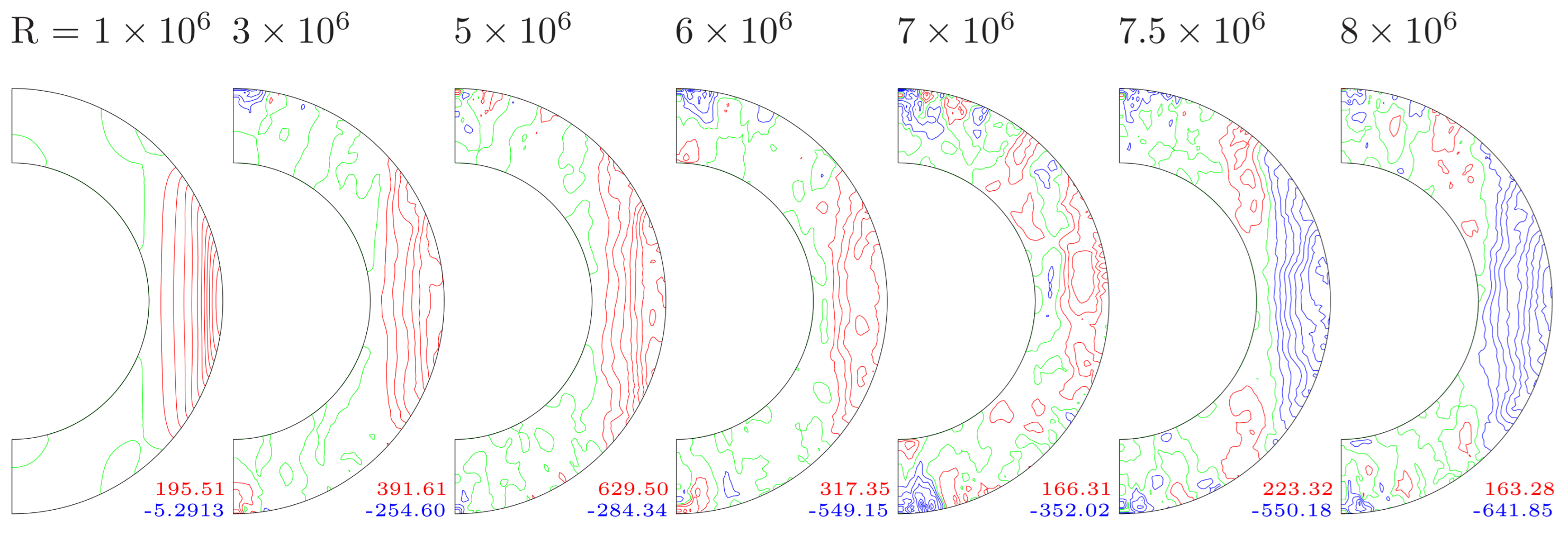
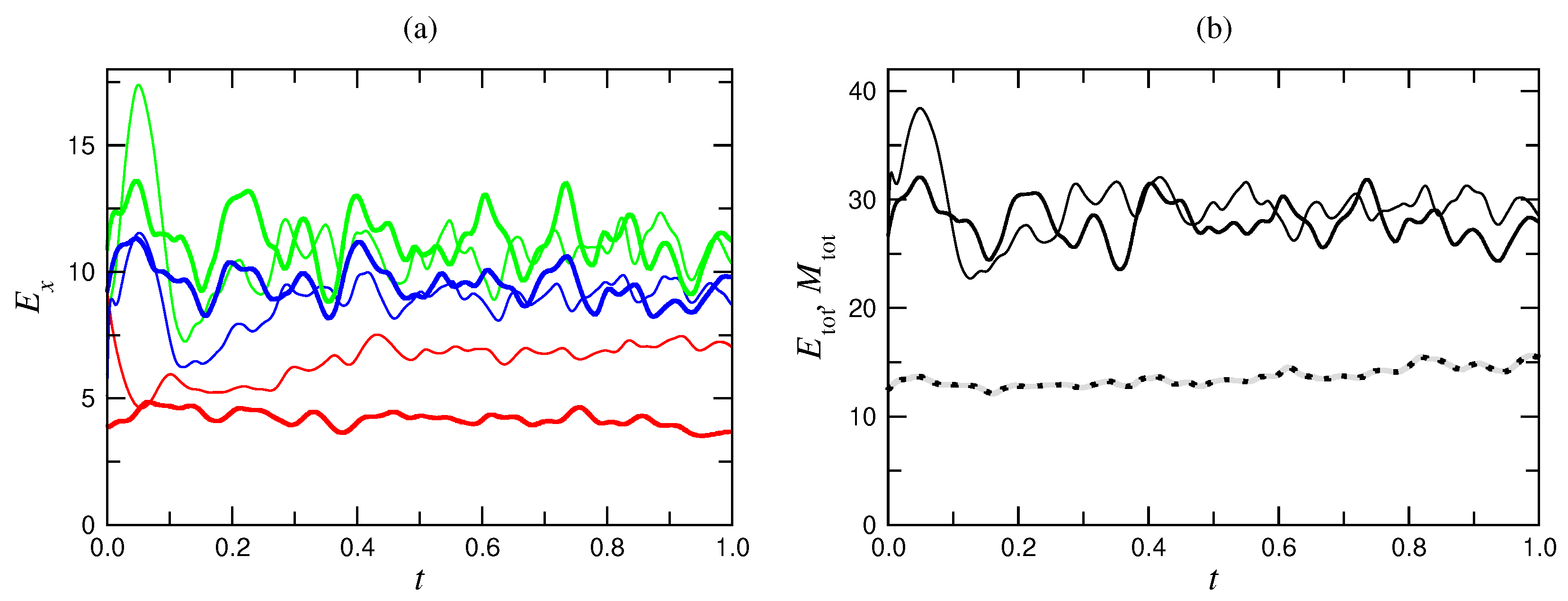
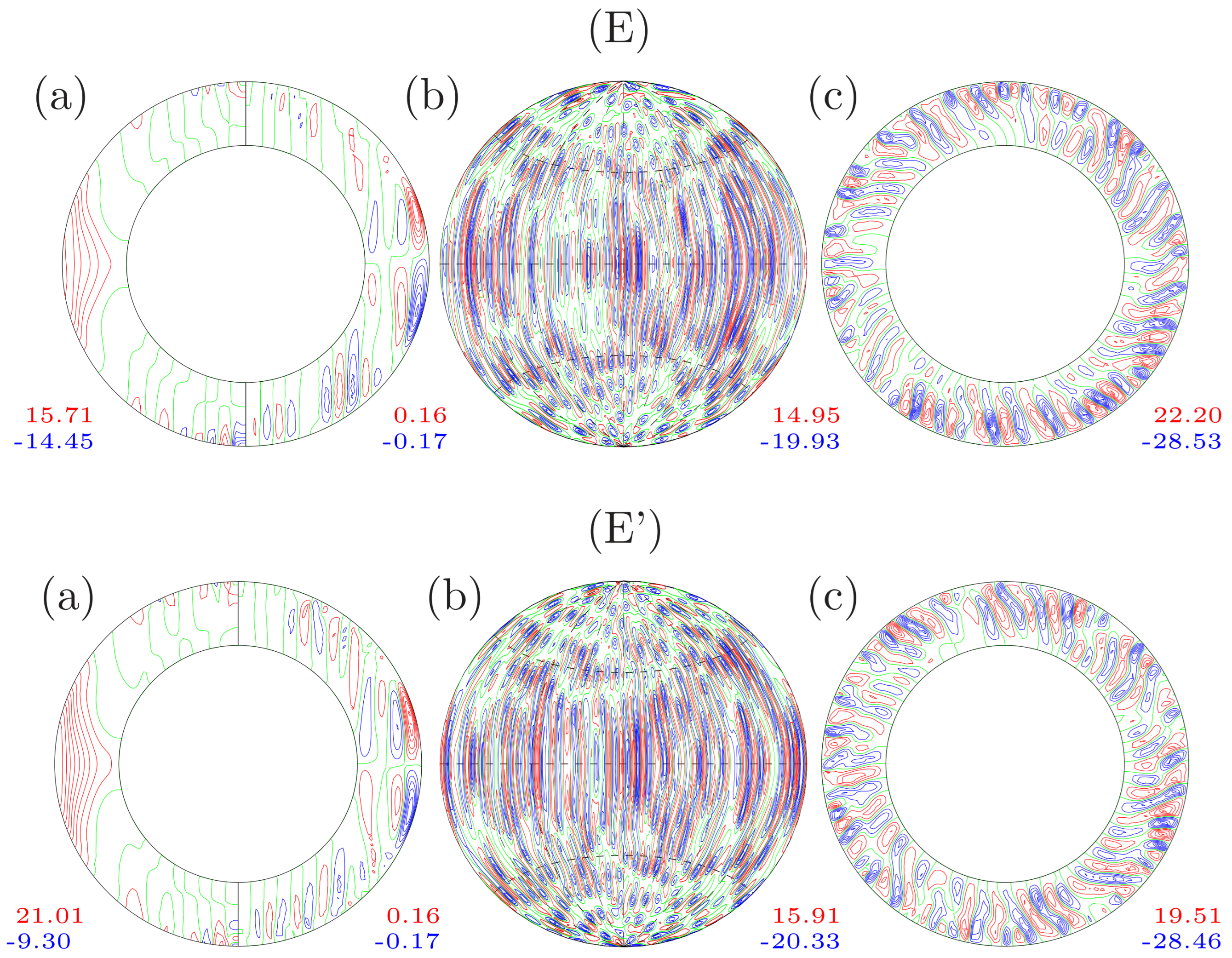
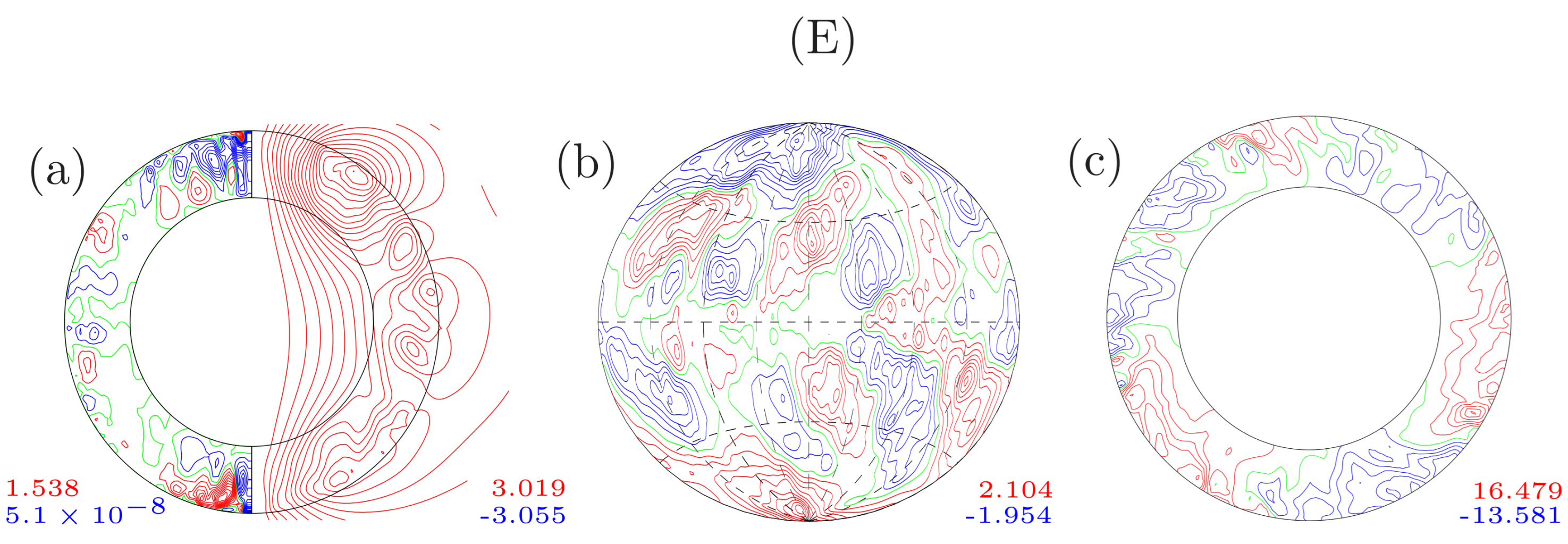
| A | B | C | D | E | F | |
|---|---|---|---|---|---|---|
| Uniform | Non-Uniform | Uniform | Non-Uniform | Uniform | Non-Uniform | |
| 0.65 | 0.65 | 0.65 | 0.65 | 0.65 | 0.65 | |
| R | ||||||
| 2000 | 2000 | 2000 | 2000 | 2000 | 2000 | |
| 0.3 | 0.3 | 1 | 1 | 5 | 5 | |
| 3 | 3 | 3 | 3 | 3 | 3 | |
| n | 2 | 2 | 2 | 2 | 2 | 2 |
| 1 | 1 | 4 | 4 | 10 | 10 | |
| 11,785.6 | 18,627.4 | 846.488 | 1006.96 | 29.1356 | 20.9883 | |
| 23.7465 | 64.0577 | 0.97983 | 4.29216 | 0.0215626 | 0.0870345 | |
| 5930.15 | 11,540.3 | 182.149 | 570.75 | 4.7595 | 1.32042 | |
| 1946.24 | 1746.21 | 271.194 | 175.511 | 11.0902 | 6.81947 | |
| 1574.74 | 2261.39 | 207.107 | 218.885 | 9.35735 | 11.5854 | |
| 1189.03 | 0.0662693 | 464.484 | 14.92 | 21.4386 | 0.638192 | |
| 6.26582 | 0.00139628 | 4.48705 | 0.117454 | 0.463097 | 0.0718596 | |
| 13.3781 | 0.0012872 | 6.38913 | 0.129885 | 0.43025 | 0.0194026 | |
| 256.771 | 0.0164442 | 111.957 | 4.44414 | 5.34042 | 0.181853 | |
| 290.496 | 0.0153525 | 105.607 | 3.82462 | 4.41429 | 0.0936899 | |
| 153.5291 | 193.0150 | 164.5828 | 44.8767 | 76.3350 | 64.7890 | |
| 0.1535 | 0.1930 | 0.0411 | 0.0448 | 0.0076 | 0.0064 | |
| 0.0487 | 0.0003640 | 0.0304 | 0.0054 | 0.0065 | 0.001129 |
Disclaimer/Publisher’s Note: The statements, opinions and data contained in all publications are solely those of the individual author(s) and contributor(s) and not of MDPI and/or the editor(s). MDPI and/or the editor(s) disclaim responsibility for any injury to people or property resulting from any ideas, methods, instructions or products referred to in the content. |
© 2023 by the authors. Licensee MDPI, Basel, Switzerland. This article is an open access article distributed under the terms and conditions of the Creative Commons Attribution (CC BY) license (https://creativecommons.org/licenses/by/4.0/).
Share and Cite
Gupta, P.; MacTaggart, D.; Simitev, R.D. Differential Rotation in Convecting Spherical Shells with Non-Uniform Viscosity and Entropy Diffusivity. Fluids 2023, 8, 288. https://doi.org/10.3390/fluids8110288
Gupta P, MacTaggart D, Simitev RD. Differential Rotation in Convecting Spherical Shells with Non-Uniform Viscosity and Entropy Diffusivity. Fluids. 2023; 8(11):288. https://doi.org/10.3390/fluids8110288
Chicago/Turabian StyleGupta, Parag, David MacTaggart, and Radostin D. Simitev. 2023. "Differential Rotation in Convecting Spherical Shells with Non-Uniform Viscosity and Entropy Diffusivity" Fluids 8, no. 11: 288. https://doi.org/10.3390/fluids8110288
APA StyleGupta, P., MacTaggart, D., & Simitev, R. D. (2023). Differential Rotation in Convecting Spherical Shells with Non-Uniform Viscosity and Entropy Diffusivity. Fluids, 8(11), 288. https://doi.org/10.3390/fluids8110288









